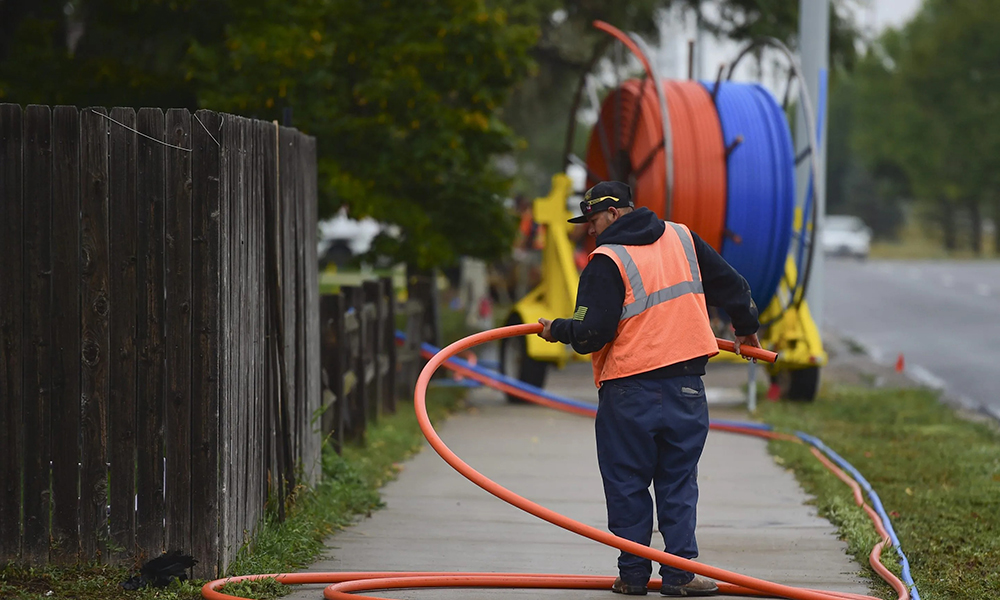
容易实现的部分已经完成了。去年11月,国会批准了一项千载难逢的两党基础设施立法,其中包括650亿美元的资金,该资金用于加速宽带部署并帮助缩小美国持续存在的数字鸿沟。
现在,更艰巨的工作开始了:如何高效且富有成效地使用这笔巨款。
立法本身包括对将进行资金分配的联邦和州政府官员的建设性指导。我们可以从联邦和州政府以前采取的举措以及私营部门提供商过去和现在的经验中收集更多有关有效宽带投资的见解。
牢记这些经验教训,以下三个基本原则有助于确保我们的宽带投资获得最大回报。
一刀切的做法不适合所有人
美国最大的特点之一是复杂多样的地形和人口多样性,但谈及联邦基础设施计划时,我们就不那么卓越了。
美国国土辽阔而且非常多样化。各州之间以及各州内不同的地方之间的实际情况差别很大。
在确定方案设计和目标时,注重宽带连接的政策制定者需要考虑多种条件,从人口密度、平均收入、地质、地形到现有的竞争产品范围。
密切配合
在联邦政府提供资金的同时,宽带计划要想成功需要联邦、州、地方政府和私营部门之间密切合作。地方领导人最了解当地的挑战,尤其是在早就承诺但仍未完全交付的联邦宽带地图缺乏的情况下。
州和地方政府官员将更直接地监督大部分支出和随后提供的服务。各州可以从任命“宽带沙皇”中受益,从而专注于缩小数字鸿沟,调查可用性缺陷及其原因,说服民众使用宽带,并积极协调各方行动。
联邦政府官员可以从国家视角出发,在全国范围内找出可以在多个行政辖区复制的成功方法。
在过去的二十年里,私营部门提供商投资了1.9万亿美元用于建设和运营宽带网络,他们带来了最重要的知识。虽然每个人都喜欢抱怨他们当地的有线电视、无线或有线运营商,但通过大量的基础设施支出,这些企业正带头建设美国的5G网络。
优先考虑连接性
我们的经济复苏正面临着持续性短缺、通货膨胀和新冠肺炎疫情带来的破坏这些挑战。气候变化导致与天气有关的灾难带来的损失越来越大,教育成果仍然因种族而出现无法让人接受的分化现象,地缘政治竞争者争夺创新领导权和技术主导地位。尽可能快地将所有美国人联系起来将有助于我们应对这些挑战。
不幸的是,在美国建设基础设施的成本比在大多数其他国家高得多。虽然导致美国建设基础设施成本较高和延误时间较长的原因有很多种,但官僚主义的惰性是成功部署宽带的最严重障碍之一。
例如,在路易斯安那州的杰斐逊教区,有数十份光纤部署许可证仍未获得批准,其中一些许可证早在去年1月就已提交。2021年3月,教区承诺在两周内批准许可证。然而几个月后,尽管教区委员会采取行动敦促教区推进许可证批准进程,但教区的企业和居民仍在等待这一关键的基础设施连通。
教区的担忧主要集中在美观方面,这是因为他们期望要求未来的光纤部署者在部署光纤之前拆除铜线。除了威胁到仍然依赖铜线宽带的客户获得持续服务外,这些反对意见还推迟了对更先进网络的投资。
宽带建设要想取得成功,政策制定者需要明白国会拨款不是终点,而仅仅是起点的终点。 只有通过与私营部门领导人合作,向当地居民学习,并优先考虑官僚主义的灵活性而不是党派意识形态,我们才能实现普及宽带的目标。(财富中文网)
布鲁斯·梅尔曼(Bruce P. Mehlman)是前美国商务部负责技术政策的助理国务卿,也是互联网创新联盟的创始联合主席。
容易实现的部分已经完成了。去年11月,国会批准了一项千载难逢的两党基础设施立法,其中包括650亿美元的资金,该资金用于加速宽带部署并帮助缩小美国持续存在的数字鸿沟。
现在,更艰巨的工作开始了:如何高效且富有成效地使用这笔巨款。
立法本身包括对将进行资金分配的联邦和州政府官员的建设性指导。我们可以从联邦和州政府以前采取的举措以及私营部门提供商过去和现在的经验中收集更多有关有效宽带投资的见解。
牢记这些经验教训,以下三个基本原则有助于确保我们的宽带投资获得最大回报。
一刀切的做法不适合所有人
美国最大的特点之一是复杂多样的地形和人口多样性,但谈及联邦基础设施计划时,我们就不那么卓越了。
美国国土辽阔而且非常多样化。各州之间以及各州内不同的地方之间的实际情况差别很大。
在确定方案设计和目标时,注重宽带连接的政策制定者需要考虑多种条件,从人口密度、平均收入、地质、地形到现有的竞争产品范围。
密切配合
在联邦政府提供资金的同时,宽带计划要想成功需要联邦、州、地方政府和私营部门之间密切合作。地方领导人最了解当地的挑战,尤其是在早就承诺但仍未完全交付的联邦宽带地图缺乏的情况下。
州和地方政府官员将更直接地监督大部分支出和随后提供的服务。各州可以从任命“宽带沙皇”中受益,从而专注于缩小数字鸿沟,调查可用性缺陷及其原因,说服民众使用宽带,并积极协调各方行动。
联邦政府官员可以从国家视角出发,在全国范围内找出可以在多个行政辖区复制的成功方法。
在过去的二十年里,私营部门提供商投资了1.9万亿美元用于建设和运营宽带网络,他们带来了最重要的知识。虽然每个人都喜欢抱怨他们当地的有线电视、无线或有线运营商,但通过大量的基础设施支出,这些企业正带头建设美国的5G网络。
优先考虑连接性
我们的经济复苏正面临着持续性短缺、通货膨胀和新冠肺炎疫情带来的破坏这些挑战。气候变化导致与天气有关的灾难带来的损失越来越大,教育成果仍然因种族而出现无法让人接受的分化现象,地缘政治竞争者争夺创新领导权和技术主导地位。尽可能快地将所有美国人联系起来将有助于我们应对这些挑战。
不幸的是,在美国建设基础设施的成本比在大多数其他国家高得多。虽然导致美国建设基础设施成本较高和延误时间较长的原因有很多种,但官僚主义的惰性是成功部署宽带的最严重障碍之一。
例如,在路易斯安那州的杰斐逊教区,有数十份光纤部署许可证仍未获得批准,其中一些许可证早在去年1月就已提交。2021年3月,教区承诺在两周内批准许可证。然而几个月后,尽管教区委员会采取行动敦促教区推进许可证批准进程,但教区的企业和居民仍在等待这一关键的基础设施连通。
教区的担忧主要集中在美观方面,这是因为他们期望要求未来的光纤部署者在部署光纤之前拆除铜线。除了威胁到仍然依赖铜线宽带的客户获得持续服务外,这些反对意见还推迟了对更先进网络的投资。
宽带建设要想取得成功,政策制定者需要明白国会拨款不是终点,而仅仅是起点的终点。 只有通过与私营部门领导人合作,向当地居民学习,并优先考虑官僚主义的灵活性而不是党派意识形态,我们才能实现普及宽带的目标。(财富中文网)
布鲁斯·梅尔曼(Bruce P. Mehlman)是前美国商务部负责技术政策的助理国务卿,也是互联网创新联盟的创始联合主席。
The easy part is over. Congress approved once-in-a-generation bipartisan infrastructure legislation last November, including $65 billion dollars to accelerate broadband deployment and help close persistent digital divides across the United States.
Now the much harder work begins: spending this extraordinary amount of money efficiently and productively.
The legislation itself included constructive guidance for the federal and state officials who will be allocating the funds. We can glean additional insights for effective broadband investments from previous initiatives undertaken by federal and state governments and based on the past and ongoing experiences of private sector providers.
With those lessons learned in mind, here are three basic principles to help ensure maximum return on our broadband investments.
One size does not fit all
One of the greatest attributes of the United States, our rich diversity in geography and demography, is less great when it comes to federal infrastructure initiatives.
Our nation is really big! And it’s remarkably varied. Facts on the ground differ widely from state to state and among distinct localities within states.
Policymakers focusing on broadband connectivity need to consider a myriad of conditions, from population density, average incomes, geology, and topography to the range of competitive offerings already available, when determining program design and objectives.
Coordinate closely
While the federal government is supplying the funding, successful broadband initiatives will demand close cooperation between federal, state, local, and private sector players. Local leaders understand local challenges best, especially in the absence of the long-promised-but-still-not-quite-delivered federal broadband maps.
State and local officials will more directly oversee much of the spending and subsequent offering of services. States can benefit from appointing “broadband tzars” to focus maniacally on closing digital divides, investigate availability shortcomings and their causes, proselytize adoption, and actively coordinate efforts among all players.
Federal officials can bring essential national perspectives and identify successful approaches from across the nation that can be replicated in multiple jurisdictions.
Private sector providers, who invested $1.9 trillion in building and operating broadband networks over the past two decades, bring the most critical knowledge of all. While everyone enjoys complaining about their local cable, wireless or wireline carrier, these businesses are spearheading the effort to build America’s 5G networks with their large infrastructure spending.
Prioritize connectivity
Our economic recovery is facing persistent shortages, inflation, and COVID disruptions. Climate change precipitates increasingly expensive weather-related disasters, educational outcomes remain unacceptably divided by race, and geopolitical competitors vie for innovation leadership and technological dominance. Connecting all Americans as rapidly as possible will help us tackle these challenges.
Unfortunately, it’s a lot more expensive to build infrastructure in the United States than in most other countries. While multiple reasons explain America’s higher costs and longer delays, bureaucratic inertia stands as one of the most significant barriers to successful broadband deployment.
In Jefferson Parish, Louisiana, for example, dozens of permits for fiber-optic deployment remain outstanding, some of which were filed as far back as January of last year. In March of 2021, the Parish committed to approving permits in two weeks. Yet many months later, and despite actions by the Parish Council urging the Parish to move forward, businesses and residents of the Parish are still waiting for this critical connectivity.
Some of the Parish’s concerns centered around aesthetics, as they wanted to require would-be fiber builders to remove copper facilities prior to deploying fiber optics. In addition to threatening continued service for customers still relying on broadband over copper lines, such objections delay investment in more advanced networks.
If the great broadband buildout is to succeed, policymakers need to understand that Congress appropriating the money is not the end, but merely the end of the beginning. Only by partnering with private sector leaders, learning from local residents, and prioritizing bureaucratic flexibility over partisan ideology will we realize the universal broadband objective.
Bruce P. Mehlman is a former Assistant Secretary of Commerce for Technology Policy and founding co-chairman of the Internet Innovation Alliance.






